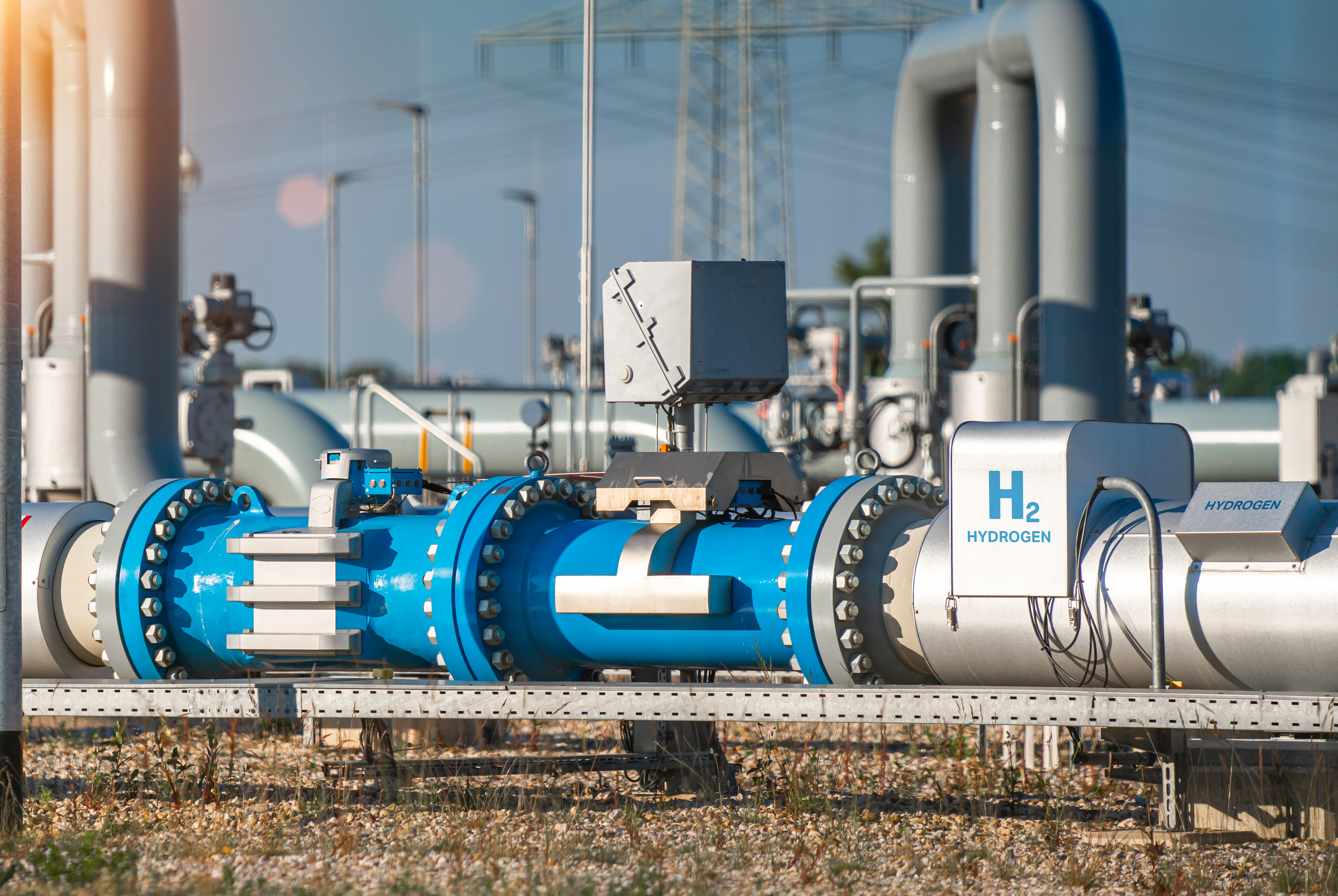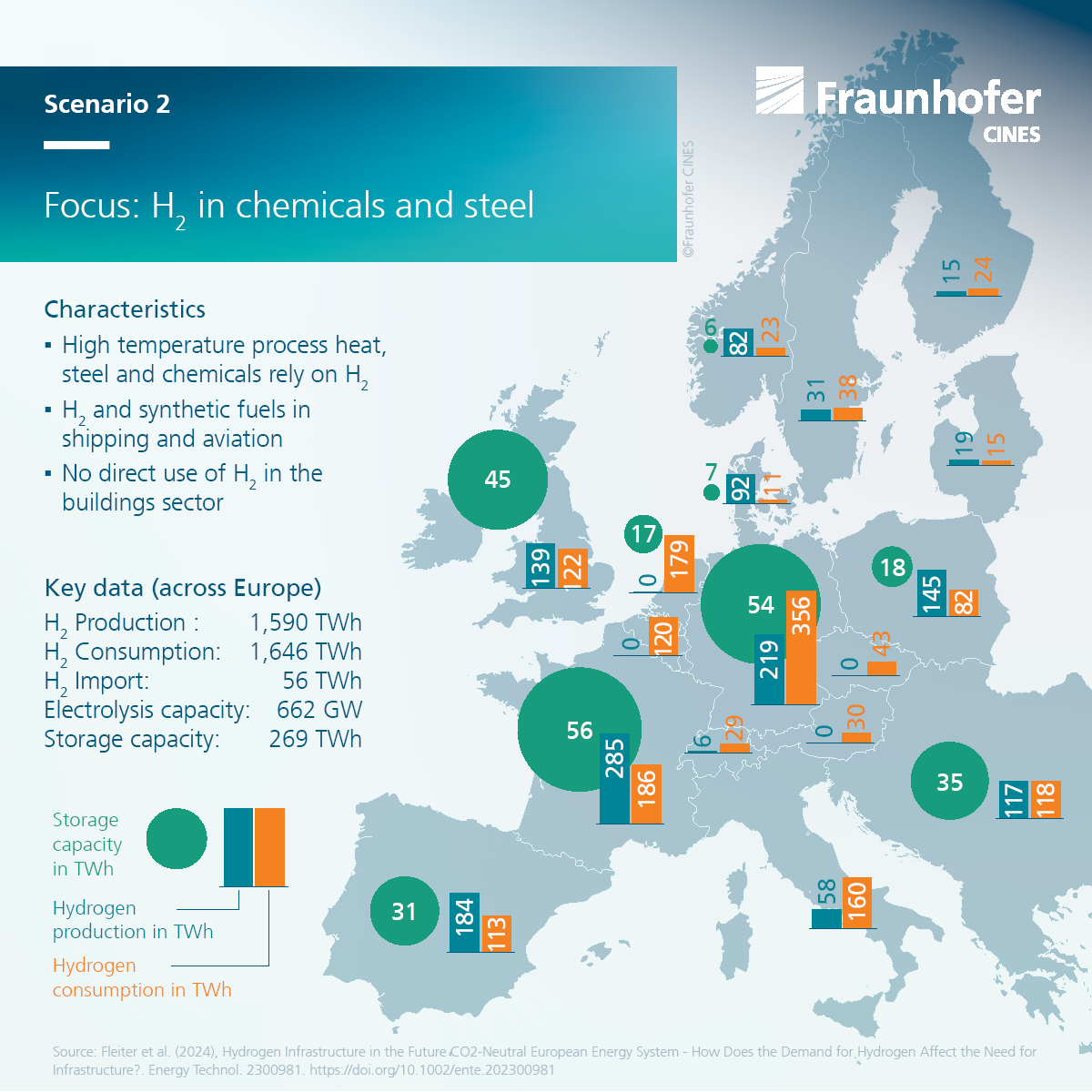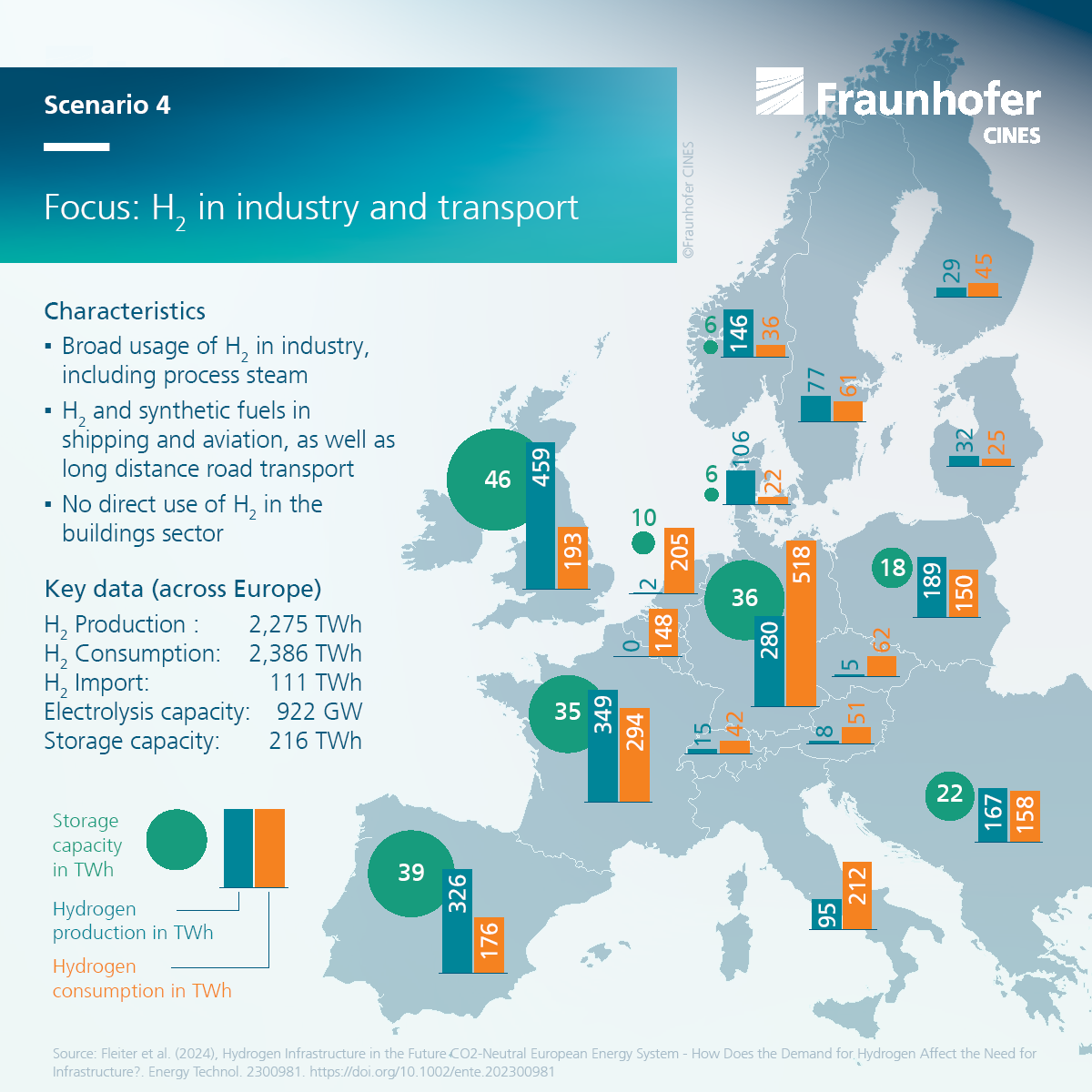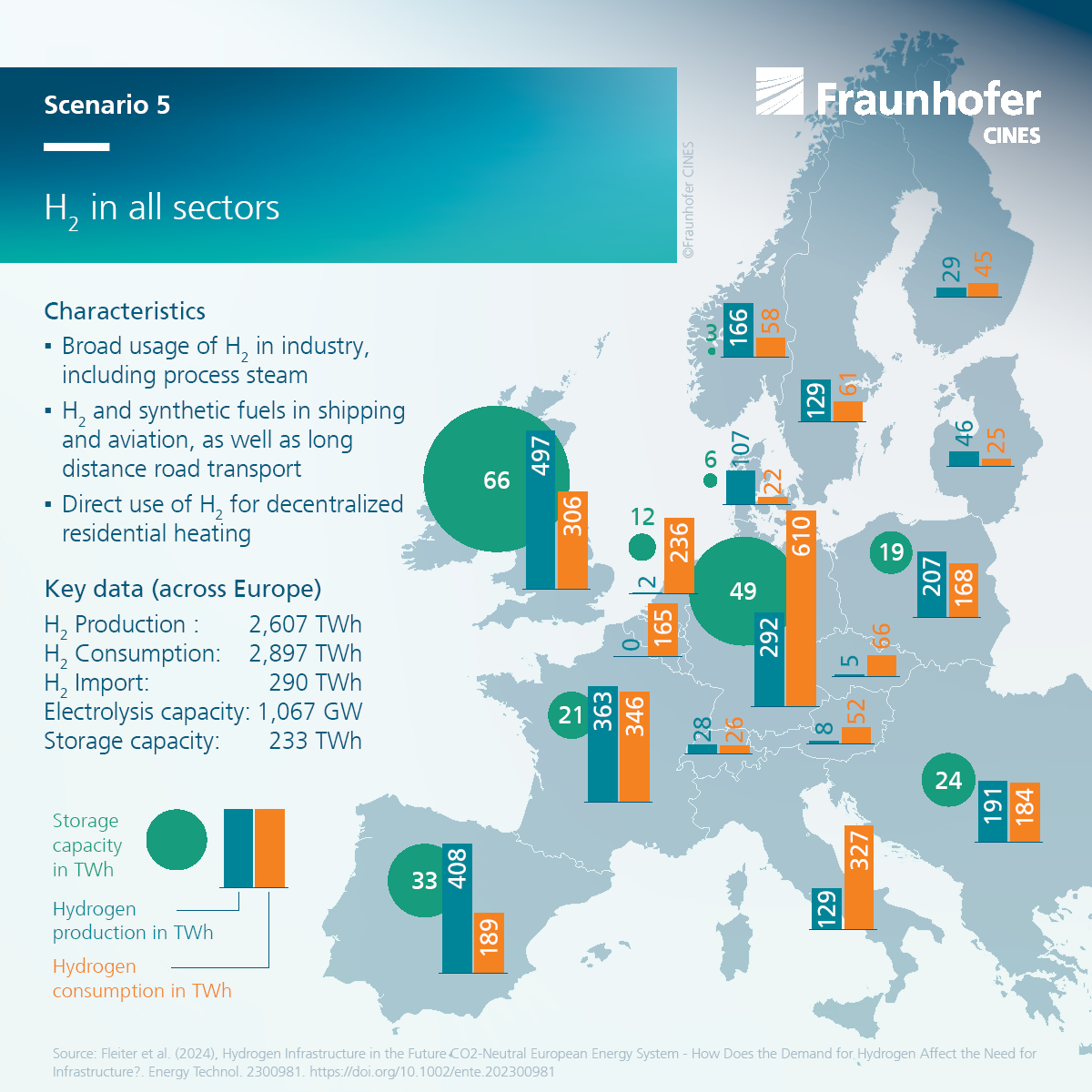New TransHyDE study: Green hydrogen infrastructure optimizes costs and efficiency in Europe's climate-neutral energy system
Green hydrogen is considered a key technology for Europe’s climate-neutrality. However, the urgent ramp-up of technologies and markets faces major uncertainties regarding the future demand for hydrogen and the corresponding infrastructure - a dilemma that is hampering strategic decisions and concrete planning. Researchers from the Fraunhofer Cluster of Excellence »Integrated Energy Systems«« (CINES) have analyzed scenarios for the pan-European energy system in the years 2030 and 2050. They show that even with low hydrogen demand, a considerable build-up of hydrogen infrastructure is necessary.

The study simulates five different development paths for the European energy system and assesses their demand for hydrogen and its derivatives. Assuming that in each case the most cost-effective energy system is implemented, the researchers calculated the amount of hydrogen infrastructure that will be required in 2030 and 2050 to cover the respective demand. They show that even with the lowest expected hydrogen demand, all key elements of its infrastructure, i.e. electrolysers, transport corridors and storage facilities, will be required on a large scale. Dr. Tobias Fleiter, lead author of the study and head of the ‘Energy System Analysis’ dimension at Fraunhofer CINES, explains the study’s background: »Until now, there has been a great uncertainty as to whether and to what extent the infrastructure will be necessary at all. This has been an obstacle to many hydrogen strategies and investments in the corresponding technologies. For the first time, our research has enabled us to make a robust statement about infrastructure requirements in Europe as a whole.« Fleiter is also the coordinator of the business unit for demand analyses and projections at the Fraunhofer Institute for Systems and Innovation Research ISI.
On-site electrolysis in Europe over hydrogen imports
The minimum scenario for hydrogen demand in Europe in 2050 is estimated at about 700 terawatt hours (TWh), which includes the reliable assumption of hydrogen consumption for parts of industrial process heat, power plants, district heating, and intra-European air traffic, which are otherwise hard to electrify. In the maximum scenario, on the other hand, demand rises to up to 2,800 TWh. The most important reason for this wide range is a great uncertainty regarding the future use of hydrogen as a raw material in the chemical industry. Geographically, the researchers estimate that a focus will develop around the chemical and steel industry locations in north-western Europe, particularly in North Rhine-Westphalia, the Netherlands and Flanders.
The projected demand can largely be covered by European hydrogen production. Imports only account for around 10 percent of total demand, even in the maximum scenario. »Assuming that the energy system is expanded at close to optimal cost, green hydrogen produced in Europe remains more than competitive with imports,« says Tobias Fleiter, head researcher of the study. »The additional costs for transportation from North Africa and the Middle East compensate for the low production costs there.«
Depending on the scenario, the electrolysis capacity required in Europe ranges between 54 and 107 gigawatts (GW) in 2030 and 300 and 1,067 GW in 2050. In all scenarios, new locations for electrolysis facilities first develop along wind energy sites with favorable levelized cost of electricity – above all on the coasts of the British Isles, Norway, northwest Germany, and France. In the longer term, sunny locations in southern Europe will follow, particularly on the Iberian Peninsula, the Balkans and in Italy.
Transport corridors and storage
Furthermore, all scenarios in the study show that on-site electrolysis at favorable solar and wind locations is the more cost-efficient option compared to electrolysis close to consumption, e.g. near large industrial consumers. »This result clearly shows how efficiently we can transport large amounts of energy as hydrogen across the entire continent, compared to transportation via the electricity grid,« says Fleiter.
Therefore, infrastructure for transporting hydrogen within Europe is essential. The most important transport corridors lead from the British Isles and Norway to the north-west of continental Europe, while France will become a transit hub for hydrogen from Spain and Portugal.
In 2050, balancing hydrogen production and consumption on a seasonal basis will require hydrogen storage facilities with a pan-European capacity of 215 - 300 TWh. If all of today's existing natural gas storage facilities were converted for hydrogen storage, they would have a capacity of 225 TWh. »For this reason, we can definitely include the conversion of our natural gas storage facilities as a robust element into our transformation strategies,« Tobias Fleiter confirms.
Reducing uncertainties
The methodology used by the CINES researchers models Europe's future energy system in high temporal and spatial resolution, taking into account numerous influencing variables such as technologies, prices, regulatory framework conditions and weather data. Tobias Fleiter’s outlook is clear: »Now we have the tools necessary to take a closer look at other uncertainty factors for the future hydrogen system. These include, for example, various expansion paths for renewable energies, so-called blue hydrogen, biomass, and CCS (carbon capture and storage).«
The study was conducted as part of the TransHyDE hydrogen lighthouse project of the Federal Ministry of Education and Research (BMBF).
More Information
Recommended citation:
Fleiter, T., Fragoso, J., Lux, B., Alibaş, Ş., Al-Dabbas, K., Manz, P., Neuner, F., Weißenburger, B., Rehfeldt, M. and Sensfuß, F. (2024), Hydrogen Infrastructure in the Future CO2-Neutral European Energy System—How Does the Demand for Hydrogen Affect the Need for Infrastructure?. Energy Technology 2300981. https://doi.org/10.1002/ente.202300981
 Cluster of Excellence Integrated Energy Systems
Cluster of Excellence Integrated Energy Systems


